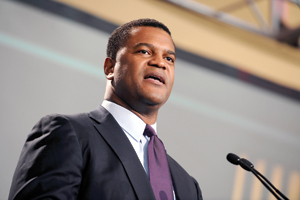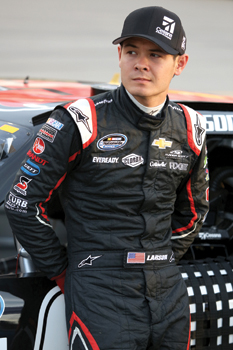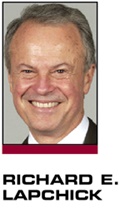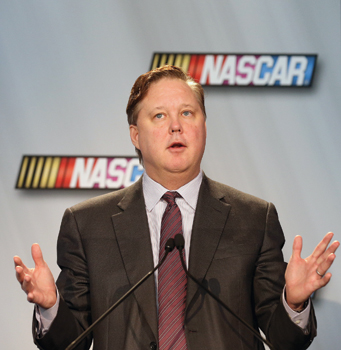The first time I met Brian France, in 1997, he told me he wanted NASCAR to look like America. That was not the image I had of what NASCAR was or what it wanted, but there was something about the way France said it that convinced me he meant it.
Up to that moment, my impression of NASCAR included Confederate flags and mostly all-white Southern fans. While that impression hasn’t changed much through the years, every interaction I have had with France and with NASCAR during that time has affirmed my initial assessment of France’s comments. I have co-chaired a 10-person NASCAR Diversity Council with Magic Johnson, observed all the NASCAR programs aimed at promoting diversity, and engaged with NASCAR through the National Consortium for Academics and Sports, which I founded in 1985, and the DeVos Sport Business Management Program at the University of Central Florida, which I chair.
I am convinced that my gut was right after that first meeting with France and that he meant what he said.
During my career, I have had a positive reputation with the media, but the media has always challenged me when I have said that NASCAR was making major efforts on diversity, as it did not fit the public image of NASCAR. My response to those challenges, then and now, is to detail the efforts NASCAR has made.
For example, Teamwork Leadership Institute, which is a program of the NCAS, has provided training to the NBA, MLS and hundreds of college athletics departments. NASCAR has done more than any other league or college by training each of its employees in each of the last six years with a total investment of more than $500,000. It could have publicized these efforts as a way to change its public image, but NASCAR kept the training to itself. It did this because it was the right thing to do and the only way to effectively change a traditional culture. But changing the public perception remains an uphill battle.
 |
|
 |
Hiring Jadotte (left) and developing drivers like Larson show France and NASCAR’s commitment to diversity.
Photo by: GETTY IMAGES (3) |
With our NCAS team, I recently addressed the NASCAR leadership team, including France. Our goal was to make diversity and inclusion a part of what NASCAR does with its fans, vendors, sponsors and business partners. In the early days of diversity management training, it was said that diversity was a moral imperative. Now we know it is a business imperative.
The demographics of America have changed and will continue to change even more. I asked the leaders how such future changes will affect NASCAR’s fan base. How is NASCAR preparing for that? How is NASCAR’s leadership preparing NASCAR employees to help with that change?
With other sports, when fans and the media have thought about diversity, the players have always been the original focus. Over decades, MLB, the NFL, the NBA, and later MLS and the WNBA have become sports with highly integrated player bases. Between 40 percent and 80 percent of the players in those leagues are players of color.
NASCAR’s diversity initiatives are helping it join the race, but it started from so far behind with its programs for diverse driver development and efforts beyond its highly touted Drive for Diversity program. The topic was particularly timely after all the attention that was paid to Danica Patrick at the Daytona 500. Fewer people noticed that Kyle Larson, who is Japanese-American, made his national series debut this season in the Nationwide Series, where he is a leading candidate for Rookie of the Year. He also races in the NASCAR Camping World Truck Series, where he finished first at Rockingham and became the first graduate of the Drive for Diversity program to win in one of NASCAR’s top three series.
The question, of course, is how will Larson and others advance to the next level of competition?
Beyond the players, MLB, NFL, NBA, WNBA and MLS have been pushed since the 1980s by the lack of diversity in league offices and at teams. There has been dramatic change, especially in the league offices. They are all doing quite well on racial hiring practices and doing better, though not great, with gender hiring. NASCAR has made progress in its headquarters hires with two people of color and eight women among the 26 people on the board and as officers of the organization, but there is still a great deal of room for more opportunities.
Our inclusion efforts must not only change the numbers but also change the culture. Diversity management training has played a significant role in changing the culture by spending eight-hour days with small groups of NASCAR employees openly discussing the challenging issues of diversity and inclusion. No sport has done more than NASCAR regarding such training. The hiring in 2005 of Marcus Jadotte, who is now NASCAR’s vice president of public affairs and multicultural development, was the key. Jadotte and France have helped position the leadership to be part of their diversity efforts by having special, intense training with the leadership on a regular basis, and that should speed NASCAR’s efforts in the years ahead. It will take significant resources at a time when resources are less available. In hard economic times, diversity programs are usually the first to go. At NASCAR, continuing with diversity efforts is a prominent signal that NASCAR is committed for the long haul.
NASCAR also has taken a leadership role with Beyond Sport United, the world’s largest effort to bring about positive social change through sport. France is the only commissioner who has personally attended the four major meetings in New York and London, and his presence spoke volumes.
I often talk and write about the power of sport to do amazing things in our world. If women and people of color excel in the world of sport, then the power they have to bring about positive social change is amplified enormously.
The future is promising, as were Brian France’s words 16 years ago.
Richard E. Lapchick (rlapchick@ucf.edu) is the director of The Institute for Diversity and Ethics in Sport at the University of Central Florida, which annually publishes racial and gender report cards on MLB, the NBA and WNBA, NFL, college sports, and the APSE.







